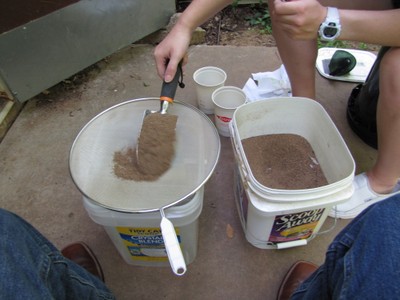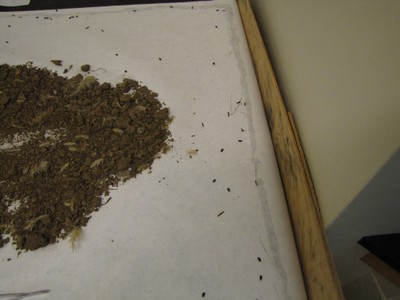The Litter Beetle Project
Introduction
- The most common of the litter beetles is the lesser mealworm Alphitobius diaperinus
- Vector and competent reservoir of several poultry pathogens and parasites
- Causes damage to poultry housing and is suspected to be a health risk to humans in close contact with larvae and adults
- Adults can become a nuisance when they move en masse towards artificial lights generated by residences near fields where beetle-infested manure has been spread
Life Cycle and Biology
- After mating, a female beetle will on average lay 200 to 400 eggs
- Adults lay their eggs in cracks and crevices in the poultry house, in manure or litter, in grain hulls, and under feed and water lines
- Adults can live three to twelve months, with females continuing to produce eggs most of their life at one to five day intervals
- Larvae hatch in four to seven days and complete development to the adult stage in 40 to 100 days, depending on temperature and food quality
- Environmental conditions required for optimum development are 70° to 95°F
- Beetles prefer the litter to contain 12% moisture but can thrive when moisture levels are higher
- Both the larval and adult stages are primarily nocturnal, with greatest activity occurring at dusk
- Adults are long lived, normally persisting for more than a year, and under experimental conditions have survived for more than two years
- A typical adult can live up to a year (365 days)
- An adult female has the potential to lay 200 eggs every 5 days
- 365 / 5 = 73 * 200 = 14,600 / 12 mo. = ~1,200 eggs / month
Damage Caused to Poultry House
- When searching for suitable pupation sites, larvae will chew holes in styrofoam, fiberglass, and polystyrene insulation panels in the walls of poultry houses
- Energy costs in beetle-damaged broiler houses are reported to be 67% higher than in houses without beetle damage
Medical & Veterinary Importance
Important vectors of a number of poultry pathogens and parasites:
- Marek's disease
- Gumboro disease
- Turkey coronavirus
- Newcastle disease
- Avian influenza
- Salmonella typhimurium
- Escherichia coli
- Aspergillus spp.
- Staphylococcus ssp.
- Eimeria spp. that cause coccidiosis
Monitoring Infestation
- Monitoring is a key function that allows the operator to make sound pest management decisions
- Preference of mealworm larvae and adults to get under objects has been used to develop a trap to monitor them in poultry litter
- No treatment guidelines in terms of numbers of beetles caught
- Detect them early and look at changes in trap counts over time
- Trap catches also let you evaluate control measures that have been applied
- Trap is a 9-inch length of 1-1/2 inch PVC pipe
- Contains a piece of 8-inch x 11-inch corrugated cardboard rolled up so that the 8-inch length is inside the pipe
- Litter beetle adults and larvae will crawl between the cardboard layers to hide
- Holes should be drilled at each end of the pipe so that stakes can be used to hold the trap in place in the litter
| Figure 1-2 | |
|---|---|
 |
Figure 1. Example of PVC Trap. |
 |
Figure 2. Population maps of the lesser mealworm in a broiler facility having each successive week grouped with its respective flock grow-out. (A) Adult lesser mealworm population. (B) Larval lesser mealworm population. Strother and Steelman, 2001, Environ. Entomol. 30: 556 - 561 |
Project Details
This project is currently still in the research phase. Information will be posted as its gathered and processed.
Images and sorting techniques
| The following pictures show the collection process of litter beetles from samples of litter taken from poultry houses. |
|---|
 |
 |
 |
 |
 |
